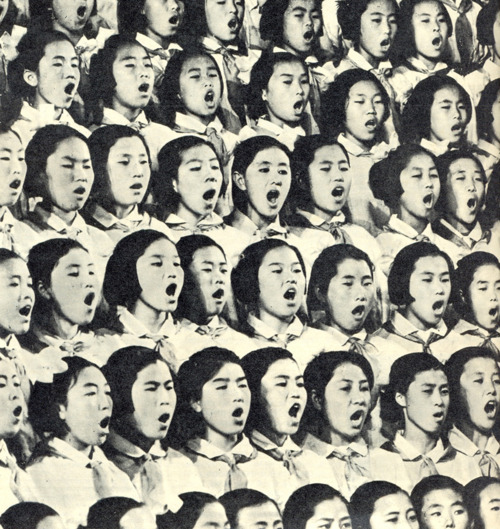Tuesday, November 13, 2012
Monday, November 12, 2012
▍ ▎ ▏ ▐Stream Fatima Al Qadiri’s Desert Strike EP
FADE Fatima Al Qadiri mines familiar territory on her new Desert Strike EP, and I mean that not just as a terrible pun, but as a compliment to her conceptual process. Her work has often dealt with themes of dislocation and isolation growing up in Kuwait during the first Gulf War, and true to the fragmentary, often surreal experience of childhood trauma, she has processed her emotions through the medium most natural to her. As a child, the war manifested as a ” really sad, minor key melody on the keyboard I played it to myself every day,” she tells Gawker, and in many ways, her new EP Desert Strike can be seen as that earlier piece’s grownup rejoinder—”a sort of abstract audio memoir.” It plays off the sonic themes and takes its name from a Sega Megadrive video game called Desert Strike: Return to the Gulf that Qadiri and her sister played just a year after experiencing the real trauma of war—an ironic twist that speaks to the medium’s desensitizing yet equally ameliorative power. Desert Strike is out today on Fade to Mind.
Stream: Fatima Al Qadiri’s Desert Strike EP (via Gawker)

Winter Armor For Hair, Skin and Nails|||||||||||||||||||
Externally using coconut oil for hair certainly has its benefits. But don't forget its internal application. Genes, stress, illness, malnutrition, medication, hormonal imbalance, etc. all have something to say about your hair's well-being.
Cooking with coconut oil is one easy way of maintaining good overall health including your hair. The antibacterial, antifungal, and antiparasitic blessings of this humble oil can assist tremendously in giving your hair full body and radiance.
Did you know that a poor thyroid function can have a profound impact on your hair? Very few people know that thyroid disease often manifests first in the condition of the hair. A coconut oil diet can promote normal thyroid gland activity such as controlling how your body makes protein necessary for hair roots.
CNO also reduces your need for Vitamin E which helps keep proper blood circulation towards your scalp. It also assists in making sure your follicle cells receive enough oxygen for growth.
Don't forget that scalp skin is just like the rest of your skin. For this reason, coconut oil uses for skin are just as remarkable.
As mentioned above, your hair situation is very much linked to your general well-being. Any deficiency in your body typically manifests itself first in your hair. When your body is under some sort of pressure, it re-prioritizes its processes. Your vital organs are attended to first which could starve your hair follicles of oxygenated blood.
Hair Facts
Your head has about 100,000 hair follicles. Each follicle can grow about 20 individual hairs in your lifetime. Your hair grows at an average rate of half an inch per month and falls off at around 100 strands per day.You need to understand that the condition of your hair is dependent on your overall health. No shampoo, conditioner, lotion, cream, spray, foam or whatever, can single-handedly give you enduring healthy hair. The positive effects derived from each of these methods are extremely temporary or short-term at best.
True healthy hair begins at underneath the surface of your scalp. The living part of your hair is in the hair follicle. Blood carries nutrients through arteries connected to your hair follicles. Poor eating habits and stress to name a couple can deprive your hair of sufficient nourishment making it dry and dull.
Taking care of your hair is much more than skin deep. You must approach hair care from within. Coconut oil and hair growth goes hand-in-hand and is safe and chemical-free. It replaces the natural oils your hair looses on a regular basis.
The protective environment of the skin and how coconut oil helps
Antiseptic
fatty acids in coconut oil help to prevent fungal and bacterial
infections in the skin when it is consumed and to some extent, when it
is applied directly to the skin. The only way to gain entry into the
body other than through the natural openings, such as the nose and
mouth, is by penetrating the skin. When the skin's defenses break down,
infections can result. Acne, ringworm, herpes, boils, athlete's foot,
and warts are just some of the infectious conditions that can affect the
skin and body.
The
biggest chemical barrier to infectious organisms is the acid layer on
the skin. Healthy skin has a pH of about 5, making it slightly acidic.
Our sweat (containing uric and lactic acids) and body oils promote this
acidic environment. For this reason, sweat and oil do us good.
Harmless bacteria can tolerate the acid and live on the skin, but
troublesome bacteria can't thrive and their numbers are few.
The
oil our bodies produce is called sebum. Sebum is secreted by oil
glands (sebaceous glands) located at the root of every hair as well as
other places. This oil is very important to skin health. It softens
and lubricates the skin and hair and prevents the skin from drying and
cracking. Sebum also contains medium chain fatty acids, in the form of
medium chain triglycerides, that can be released to fight harmful germs.
Our skin is
home to many tiny organisms, most of which are harmless; some are
beneficial. At least one variety of bacterium is essential to the
healthy environment on our skin. It feeds on the sebum, breaking down
the tryglycerides into free fatty acids. The bacteria actually feed on
the glycerol part of the triglyceride. This leaves fatty acids which
are now "freed" from the glycerol unit that held them together. Medium
chain fatty acids which are bound to the glycerol unit as they are in
coconut oil have no antimicrobial properties. However, when they are
broken apart into free fatty acids, they become powerful antimicrobials.
So
these bacteria convert the medium chain triglycerides (in the sebum or
on the skin) into free fatty acids that can kill disease-causing
bacteria, viruses, and fungi. The combination of the slightly acid pH
and medium chain fatty acids provides a protective chemical layer on the
skin that prevents infection from disease-causing organisms. Due
primarily to the action of bacteria, the oil on the surface of your skin
and hair is composed of between 40 and 60 percent free fatty acids.
The medium chain fatty acids in the sebum provide the protective layer
on the skin that kills harmful germs. Coconut oil is nature's richest
source of medium chain fatty acids.
Be Well...Bless>>>>>
✚[[[[[ ✚ 3-Day Silent Fast:: How to Fast From Speech

The practice of total silence done in the proper way can actually lengthen one’s lifespan.
We have been discussing the practice of silence. Our emotions
control and direct the level and tone of our voice. If one learns to
calm the mind before communicating, then one can even speak while the
mind is in a state of calm, that is, relative silence. With the mind
being calm, the voice will be smooth and reassuring, and not invite
resistance.
How far can one take the principle of saving one’s breath? Should we cease all vocal communication so that we can live longer? Should we not sing because singing uses up our breath? In the same vein, should we also not go jogging because during jogging our breaths become short and abrupt?
The answers are simple. Breath is granted to us for use. We do not wish to be wasteful nor are we being instructed to be stingy. Communication is a necessity but unnecessarily loud, hostile, angry, or hurtful communication is mindless extravagance. Furthermore, when one communicates with a sattvic mind, the peace generated will naturally deepen and lengthen our breath. Such speech is not a waste of breath.
How far can one take the principle of saving one’s breath? Should we cease all vocal communication so that we can live longer? Should we not sing because singing uses up our breath? In the same vein, should we also not go jogging because during jogging our breaths become short and abrupt?
The answers are simple. Breath is granted to us for use. We do not wish to be wasteful nor are we being instructed to be stingy. Communication is a necessity but unnecessarily loud, hostile, angry, or hurtful communication is mindless extravagance. Furthermore, when one communicates with a sattvic mind, the peace generated will naturally deepen and lengthen our breath. Such speech is not a waste of breath.
For learning to sing, one first learns diaphragmatic breathing as we saw in the quotation from Pavarotti. During singing, one stretches one’s breath to extraordinary lengths. The music imparts joyfulness to the heart and mind and thereby, again, deepens the breath.
As for jogging, we can still answer the question, though not related to matters of speech and silence, in two ways. First, even though we gasp in short breaths during jogging, its end-result is increased lung capacity, which again lengthens our breath. Secondly, there are two ways to make your jogging more effective.
Keep your mind occupied with your mantra during each step of your jog. Train yourself to breathe to the rhythm of 1:2 ratio, so that if your inhalation is to the count of four, let the exhalation be to the count of eight. Form this habit gradually.
The practice of silence is like fasting of speech. Many who undertake a food-fast do not at the same time control the other function of the mouth, speech. We have shown above the importance of this speech-fast, with or without food-fast. Spiritually, the speech-fast is even more beneficial than the food-fast.
It is possible to undertake this speech-fast only by keeping a meditative mood to bring a degree of calmness to the mind. Watching TV and not speaking, is not silence. After half a day of silence, talking on the phone for a two-hour gossip session does not make one a practitioner of silence.
There needs to be a sankalpa, or mental resolve to silence before starting; an affirmation, “I shall keep my speech silent, mind meditative and body relaxed.” Then, keeping the meditative mood, mantra-japa, and breath awareness, continue such practices during the period of silence. Make a further resolve that after the intended period of silence you will not try to make up for this ‘deprivation’ by eating or speaking a lot.
One may undertake an hour of silence daily, or half a day weekly – but not if it causes you to neglect your duties towards your family.

A swami often hears statements like, “I live alone, so I am always in silence.” That is not practice of silence, not unless one does the sankalpa, and keeps the mind in a meditative mode.
In our ashram at Rishikesh, we train people in the art and practice of silence. We often start a sadhaka on one day of silence, then increase it to three days, and further extend it to seven or 10 days. After a while, one undertakes a 40-day speech-fast with a disciplined daily schedule. Right now, at the ashram there are 15 sadhakas doing a 90-day silence combined with many hours of offerings to the sacred fire daily. Their faces are calm and aglow with the energy generated and preserved, as mental brahmacharya is an essential part of such periods of silence.
In our ashram, we have well-equipped labs with proper diagnostic facilities (like EEG) and procedures to study the neurology of meditation. We use them to diagnose sadhakas before and after their periods of silence. We hope to analyse the data with the help of leading international researchers and publish them.
Do concentrate on lengthening your lifespan to fulfil your spiritual goals.
★it a comeTh
A short film by Kahlil Joseph featuring music from the Flying Lotus album.
Buy the album: flying-lotus.com/until-the-quiet-comes/Director: Kahlil Joseph
Photography: Matthew J. Lloyd
Producer: Omid Fatemi
Underwater Cameraman / 1st AC: David Edsall
Editor: Luke Lynch
Steadicam: Dana Morris
VFX: Josh Foster @ Synapse FX
Additional FX: Andy Curtis
Color: Sean Coleman @ Company3
Titles: Stephen Serrato
Stylist: Elizabeth Birkett-Gibbs
Music: Flying Lotus
Production/Camera Assistant: Marcus Reposar
Location Manager: Big Flip
Talent: Solomon Gibbs, Storyboard P, Ishmael Gibbs and Edwin Marcelin
Special Thanks to Laura Tunstall, Chris Gibbs, Alan Algee, Rodney Passe, Patrick O’Brien-Smith, Panavision and the community of Nickerson Gardens
Filmed on 35mm in Los Angeles, CA
Berber Exploitation ▼-▼ Morocco
Berber Exploitation - MoroccoFor centuries the Berbers of Morocco have been persecuted by their Arab masters. Today even their festivals have been hijacked. Miriam is fighting to keep her language and culture, whilst fellow militant Zaid claims the Arabs have 'stolen our history.' Etched out of a beautiful, yet inhospitable and rugged land, stands Imichil, where the annual marriage market or Moussem des Fiances takes Place. It's here that the Arab government has turned an exclusive Berber celebration into a tourist fest. Shy young brides wander around the market in traditional veils as streetwise city slickers sell trinkets and souvenirs to dollar laden foreigners. The Arabs have encouraged the press to come and soak up the traditional atmosphere It's turned into objects of curiosity in the process. Hussein and his wife to be, were forced to attend the festival in order to obtain a marriage certificate. Fascinating look at a culture being silenced and yet exploited for its rich and colourful traditions.
This documentary says it all. I hate the Moroccan government so much so i’m glad they made this doc. This is a perfect documentary for all you uneducated Moroccans (Africans).
Produced by ABC Australia
Distributed by Journeyman Pictures
It's Not Just What You Eat, but When You Eat It: Link Between Fat Cell and Brain Clock Molecules Shown▲▲
ScienceDaily (Nov. 11, 2012) — Fat cells store excess energy and signal these levels to the brain. In a new study this week in Nature Medicine, Georgios Paschos PhD, a research associate in the lab of Garret FitzGerald, MD, FRS director of the Institute for Translational Medicine and Therapeutics, Perelman School of Medicine, University of Pennsylvania, shows that deletion of the clock gene Arntl, also known as Bmal1, in fat cells, causes mice to become obese, with a shift in the timing of when this nocturnal species normally eats. These findings shed light on the complex causes of obesity in humans.
The Penn studies are surprising in two respects. "The first is that a relatively modest shift in food consumption into what is normally the rest period for mice can favor energy storage," says Paschos. "Our mice became obese without consuming more calories." Indeed, the Penn researchers could also cause obesity in normal mice by replicating the altered pattern of food consumption observed in mice with a broken clock in their fat cells.
This behavioral change in the mice is somewhat akin to night-eating syndrome in humans, also associated with obesity and originally described by Penn's Albert Stunkard in 1955. The second surprising observation relates to the molecular clock itself. Traditionally, clocks in peripheral tissues are thought to follow the lead of the "master clock" in the SCN of the brain, a bit like members of an orchestra following a conductor. "While we have long known that peripheral clocks have some capacity for autonomy -- the percussionist can bang the drum without instructions from the conductor -- here we see that the orchestrated behavior of the percussionist can, itself, influence the conductor," explains FitzGerald.
Daily intake of food is driven by oscillating expression of genes that drive and suppress appetite in the hypothalamus. When the clock was broken in fat cells, the Penn investigators found that this hypothalamic rhythm was disrupted to favor food consumption at the time of inappropriate intake -- daytime in mice, nighttime in humans.
When a species' typical daily rhythm is thrown off, changes in metabolism also happen. For example, in people, night shift workers have an increased prevalence of obesity and metabolic syndrome, and patients with sleep disorders have a higher risk for developing obesity. Also, less sleep means more weight gain in healthy men and women.
Balancing Act Balancing energy levels in the body requires integrating mul¬tiple signals between the central nervous system and outlying tissues, such as the liver and heart. Fat cells not only store and release energy but also communicate with the brain about the amount of stored energy via the hormone leptin. When leptin is secreted, it causes more energy to be used and less eating via pathways in the hypothalamus.
The Penn team found that only a handful of genes were altered when the clock was broken in fat cells and these governed how unsaturated fatty acids, such as eicosapentaenoic acid (EPA) and docosahexaenoic acid (DHA) were released into the blood stream. Interestingly, these are the same fatty acids that are typically associated with fish oils. Sure enough, levels of EPA and DHA were low in both plasma and in the hypothalamus at the time of inappropriate feeding.
"To our amazement, we were able to rescue the entire phenotype -- inappropriate fatty acid oscillation and gene expression in the hypothalamus, feeding pattern and obesity -- by supplementing EPA and DHA to the knock-out animals," notes Paschos.
The findings point to a role for the fat cell clock molecules in organizing energy regulation and the timing of eating by communicating with the hypothalamus, which ultimately affects stored energy and body weight.
Taken together, these studies emphasize the importance of the molecular clock as an orchestrator of metabolism and reflect a cen¬tral role for fat cells in the integration of food intake and energy expenditure.
"Our findings show that short-term changes have an immediate effect on the rhythms of eating," says FitzGerald. "Over time, these changes lead to an increase in body weight. The conductor is indeed influenced by the percussionist."
This work was supported by the National Heart Lung and Blood Institute (RO1 HL097800) and the Medical Research Council (grant UD99999906).
Co-authors include Salam Ibrahim, Wen-Liang Song, Takeshige Kunieda, Gregory Grant, Teresa M Reyes, Fenfen Wang, and John A Lawson, all from Penn.
Share this story on Facebook, Twitter, and Google:
Story Source:
The above story is reprinted from materials provided by Perelman School of Medicine at the University of Pennsylvania, via Newswise.
Note: Materials may be edited for content and length. For further information, please contact the source cited above.
Journal Reference:
- Georgios K Paschos, Salam Ibrahim, Wen-Liang Song, Takeshige Kunieda, Gregory Grant, Teresa M Reyes, Christopher A Bradfield, Cheryl H Vaughan, Michael Eiden, Mojgan Masoodi, Julian L Griffin, Fenfen Wang, John A Lawson, Garret A FitzGerald. Obesity in mice with adipocyte-specific deletion of clock component Arntl. Nature Medicine, 2012; DOI: 10.1038/nm.2979
Subscribe to:
Comments (Atom)










